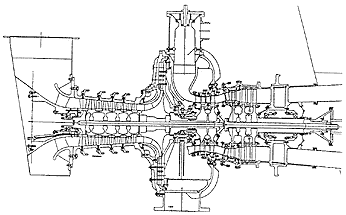As for the gas turbine for on-board generators, the MIA-25 (1,500kW) gas turbine developed by KHI itself and the 501-K34 gas turbine by Allison in US (2,500kW, manufactured by IHI) are the mainstream now. Three sets of MIA-25 were installed on two “Murasame” type DD vessels, and total 6 sets are in service and 15 sets will be installed on the succeeding five DD vessels. Three sets of 501-K34 were installed on four “Kongo” type DDG vessels, and total 12 sets are in service.
In the trend of the novel technology on the marine gas turbine, the “Technical Research Association of Super Marine Gas Turbine” comprising 5 Japanese gas turbine manufactures established in 1997 is proceeding to develop the gas turbine for marine propulsion (2,500kW class) in which the amount of NOx is about 1/10 compared with the existing diesel engines and the fuel consumption is approximately equal to that thereof. The development is to be completed by 2002. Fig. 4.1-1 shows the cross section of Super Marine Gas Turbine.

Fig. 4.1-1 Cross Section of Super Marine Gas Turbine
[Takafumi NAKAGAWA]
4.2 Turbochargers
Mitsubishi Heavy Industries Co., Ltd. (MHI) produced 475 units of MET type turbochargers. Accumulated production numbers of MET-SE type turbocharger, which had been developed for the demand of high-pressure ratio and high thermodynamic efficiency, reached 108 units. The first MET83SE turbocharger has been operated successfully since Jan. 1998. MHI contributed the paper for CIMAC Copenhagen titled “Turbocharger noise abatement in supercharging marine diesel engines with ducted-in outboard air”.
Kawasaki Heavy Industries Co., Ltd. (KHI) produced 34 units of NA type turbochargers, details are 15 units of NA48/S, 11 units of NA57/T9, 8 units of NA70/T9.8 turbochargers out of them have been delivered to Chinese engine builders and KHI has orders in hand for Chinese engine builders for the delivery in 1999. KHI developed the production process of friction welding for turbine disk and shaft together with machine tool manufacturer, of which materials are heat resisting steel and chromium molybdenum steel. This process is adopted for the production of NA48/S and NA57/T9 turbochargers. Japan Friction Welding Association awarded KHI the prize for “Superior Factory for Friction Welding”.
Mitsui Engineering & Shipbuilding Co., Ltd. (MES) produced 87 units of NA48, NA57 and NA70 turbochargers under the license of MAN-B&W in Germany. This production number is the second highest number ever reached after starting the production of turbocharger in 1981. The increasing of the production volume of marine propulsion engine is the reason. The new turbocharger type, NA48/S, NA57/T9 and NA70/T9 are produced 1 unit, 16 units and 13 units respectively. The demands for these new turbochargers are increasing due to the increasing of specific output of the diesel engine.
Niigata Diesel Co., Ltd. produced 268 units of turbochargers in total, details are 214 units of NR/R type, 4 units of NA/T type, 4 units of NR/S type under the license of MAN B&W and 46 units of conventional NHP type.
Ishikawajima-Harima Heavy Industries Co., Ltd. (IHI) and ABB KK established joint venture “Turbo Systems United Co., Ltd.” (TSU) for sales and service of turbocharger in Oct 1998. IHI, ABB KK and TSU delivered 2813 units of turbochargers in total.